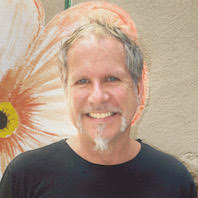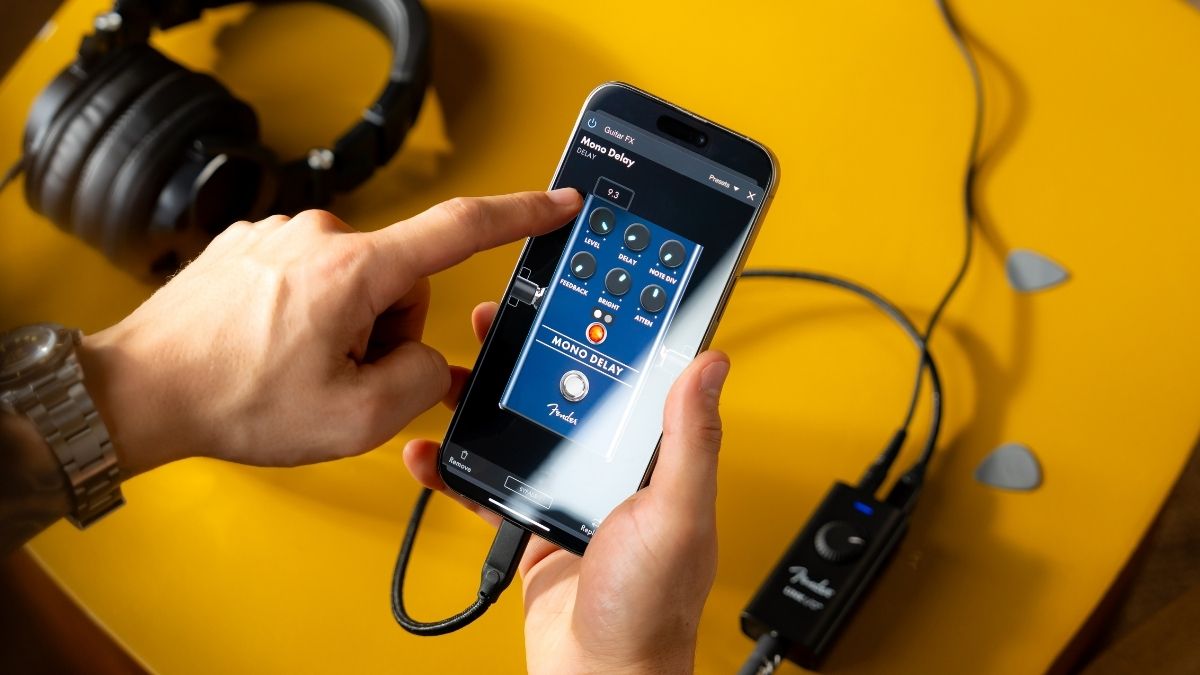Nita Strauss Steps into the Spotlight with Her New Solo Album, 'Controlled Chaos'
'Controlled Chaos' is a panoramic view of Nita Strauss' many strengths. In our Holiday cover story, one of the industry's rising stars breaks down her stellar debut.
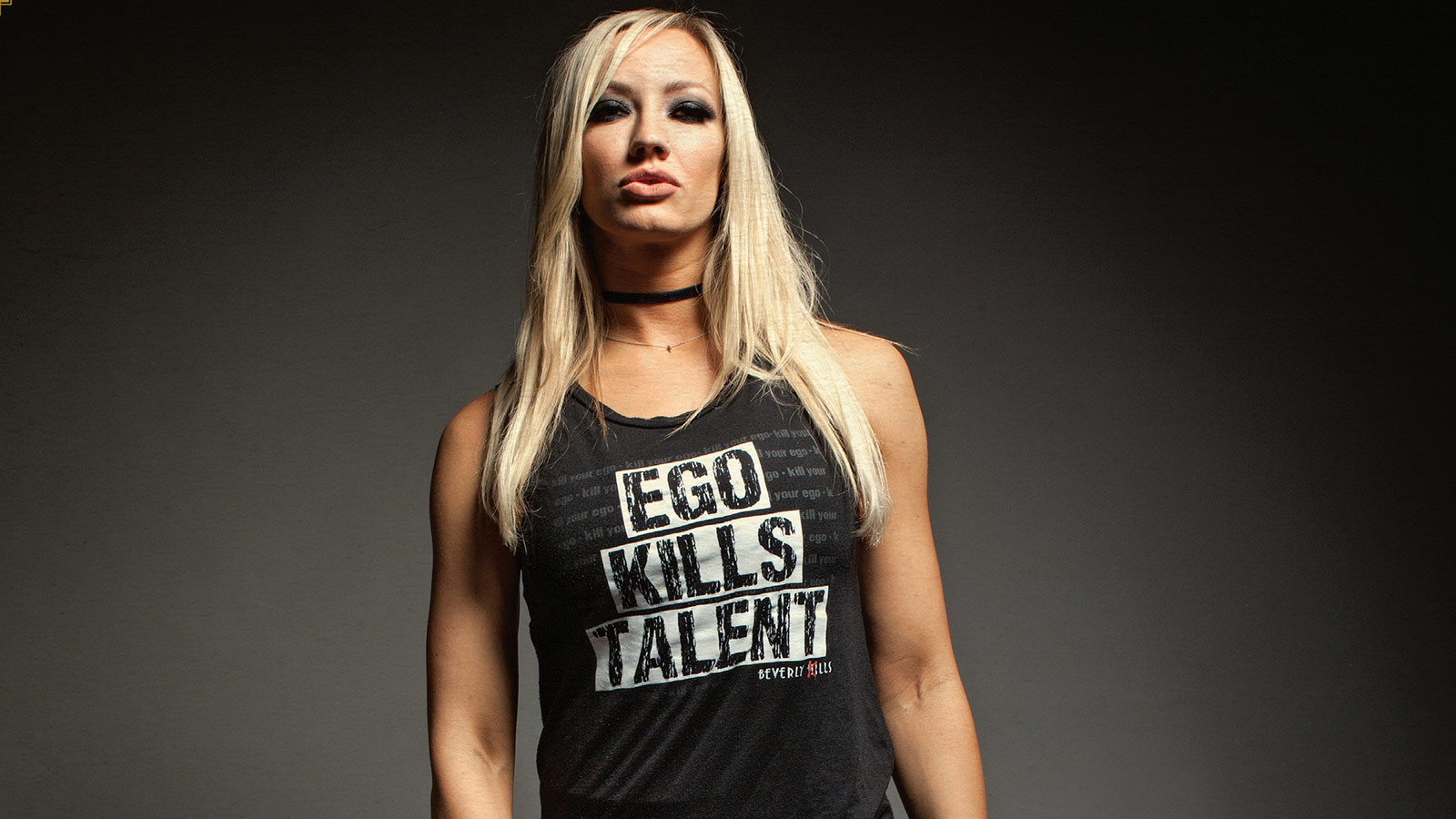
Anyone who has had the pleasure of seeing Alice Cooper’s stage show over the last couple of decades knows there’s always a helluva lot of shenanigans on stage. In recent years, prop guillotines, a smoke-spewing toy box, bosomy Goth nurses and even gigantic Frankenstein monsters wrestle for space with a five-piece band, who are equally adept at racing around as they are at playing their instruments. And, of course, there’s Cooper himself, the Supreme God of Shock Rock, who struts and menaces the crowd as if the Seventies never ended.
It’s quite a spectacle, alright — an overwhelmingly jam-packed performance, guaranteed to keep the customers “loving every moment, every scream.”
Despite the mayhem, wild theatrics and numerous macabre distractions, you can’t help watching the blonde whirling dervish with the grey-burst Ibanez guitar. For 90 minutes, Nita Strauss earns her “Hurricane” nickname as she ricochets off monitor cabinets, runs from stage left to stage right and mugs shamelessly with her legendary boss, all the while peeling off one great solo after another. She’s a rock and roll Wendy among a band of scruffy lost boys, different enough to stand out, but equal in every way.
“I heard about Nita from Kip Winger who saw her in a club,” Alice says. “I was looking for a shredder, and after I saw ‘the Hurricane,’ I thought, well… absolutely! If I give her a song like “The World Needs Guts,” or something off Brutal Planet, she’ll just eat it up. But she can play anything.”
Before Strauss joined forces with Cooper in 2014, she was already a seasoned vet, having played in L.A. clubs since she was 15. For close to a decade, she honed her chops and reputation while building an impressively eclectic resume. She may be the only guitarist in the world that can lay claim to playing funk with Jermaine Jackson of the Jackson 5, and straight up deathcore with As Blood Runs Black. However, it was her time as a member of the Iron Maidens, an all-female tribute band to the British metal legends, that put her on the map. YouTube fans in the millions enthusiastically embraced Nita and the Maidens.
“During those years with the Iron Maidens, I felt I had to be great and really prove myself at every single show,” Strauss says. “There were always people in the audience that judged me on the way I looked. They just assumed, because I was a girl, that I wasn’t going to be any good, and it motivated me to improve and nail it every night. It really prepared me, because Alice expects the best, and you have to live up to that high standard.”
Strauss has a merciless work ethic, and it has served her well. She will tell you with great pride that she grinds it out seven days a week. In addition to a relentless tour schedule with the Coop, she stays busy as one of the world’s most visible guitar clinicians and session musicians. Then, of course, there is her exceptionally important gig as occasional columnist for Guitar World. If that wasn’t enough, she recently decided to take on her biggest challenge yet — recording her very own album of instrumental guitar music, appropriately titled Controlled Chaos.
All the latest guitar news, interviews, lessons, reviews, deals and more, direct to your inbox!
As a youngster, Strauss worshiped all the master shredders — such as Steve Vai, Yngwie Malmsteen, Shawn Lane and Paul Gilbert — and the idea of recording a solo album was never far from the back of her mind. However, it wasn’t until she was asked to contribute a track to She Rocks, Vol. 1 in 2017, a compilation album featuring an impressive cast of female rock guitarists like Lita Ford, Jennifer Batten, Yasi Hofer and Orianthi, that the idea started picking up steam. Her track, “Pandemonium” was an album highlight, and it convinced her that she was ready to step out on her own and make her big statement.

“I dreamed of recording a guitar album since I started playing, but I just never felt ready,” Strauss says. “I never felt like I was the player that I wanted to be. But I had this epiphany: you’re never going to feel ready. It’s kind of like having kids. If you wait until you’re ready then you will never make that step. So, I decided to just make a snapshot of who I am as a guitar player in this moment in time.”
More than a snapshot, Controlled Chaos is a full panoramic view of her many strengths. From the kitchen sink production of the powerful “Our Most Desperate Hour,” to her soaring interpretation of Queen’s “The Show Must Go On,” the album demonstrates that the Hurricane has, indeed, landed and intends to stick around for a while.
“I got it all in there,” she says. “There’s a playful side. There’s an aggressive side. There’s a happy side. There’s a dark side. There’s a peaceful side and there’s a chaotic side. And all these different things that I experience on an hourly basis can be heard in this record.”
Your first step toward recording this album was the song “Pandemonium,” which appeared on She Rocks, Vol. 1 last year.
Yeah, that was an important step. That was an epiphany. It thought, “Okay. I can do this. I can play something that I can feel happy and proud of.”
To put my name on a track as a solo artist was a big deal to me. There was no band to act as a buffer. It meant everything was 100 percent my decision, and if the listener didn’t like it, 100 percent of the blame would go to me, and if they loved it, 100 percent of the credit would go to me. Recording “Pandemonium” and having it stand up next to some the best women guitarists in the world was a big confidence booster.
Was there a master plan for Controlled Chaos?
I wanted to make an instrumental record that was accessible to everyone, not just fans of instrumental guitar music, if that makes sense. The idea was to give each piece a conventional song structure, so non-guitarists would have a format they could follow. I see Controlled Chaos as a gateway drug into the world of instrumental music. There’s just so much incredible guitar music out there — like the new records by Jeff Loomis and Andy James — I thought that, perhaps, if the average listener enjoyed what I did, they might branch out and buy all these other great, modern shred albums that come out every year.
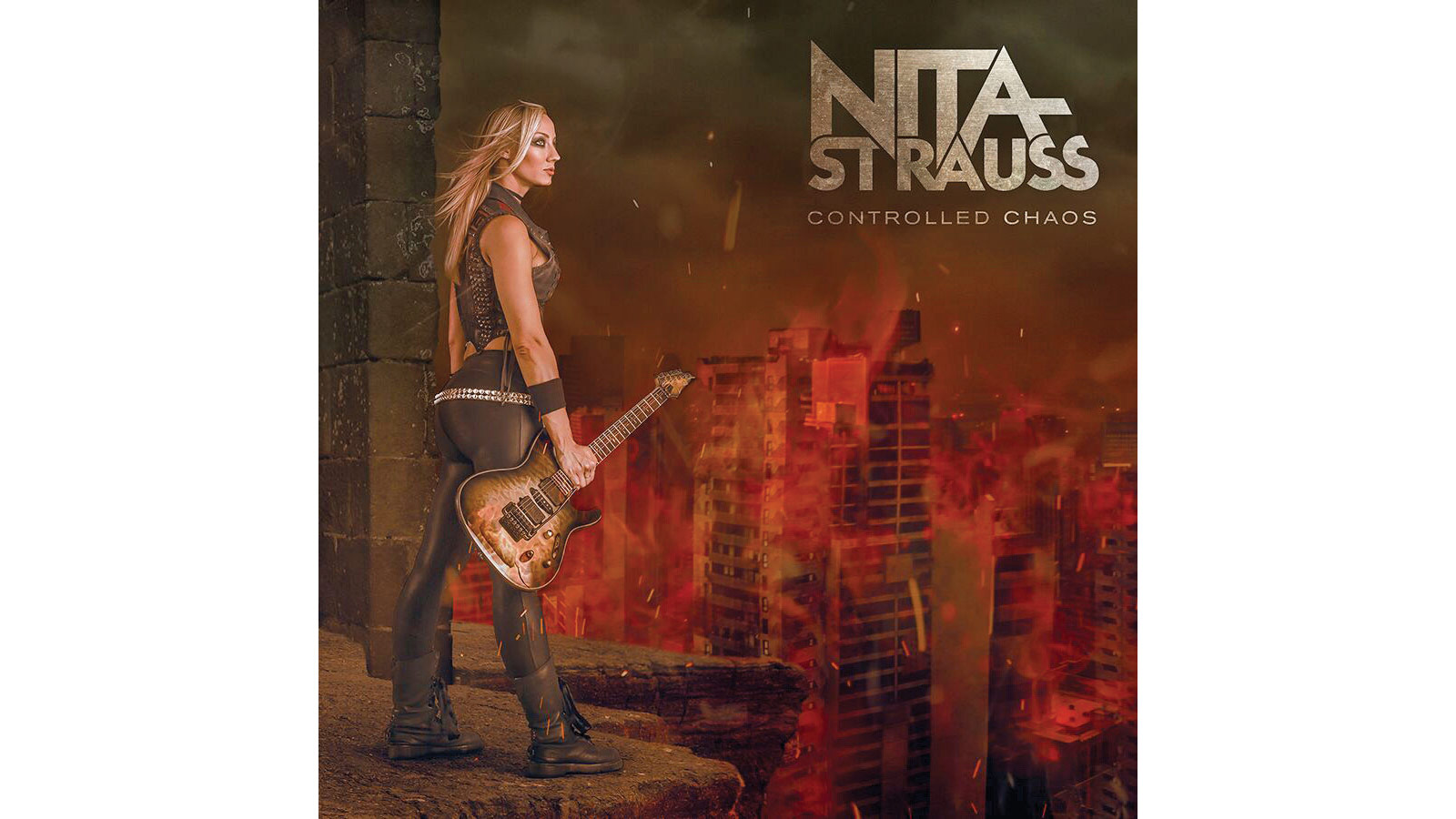
What is the significance of the title?
Most of the time it feels like my brain is in chaos, and the only way I’m able to function is to rein it in, and gain control of it, and make that chaos work in my favor. Controlled Chaos seemed like a perfect title for an album that attempts to show all sides of my personality. You can’t control what happens outside. You can’t control what happens in your life. All you can control is how you react to it.
I lead a pretty hectic lifestyle. I travel 10 months out of the year. I do seven days a week on tour, I do five shows a week with Alice. I usually do two days of clinics. I manage to go to the gym and do all this other stuff, and it gets stressful and it bears down on me. It would be very easy to just get overtaken and lay down and say, “I haven’t had a day off in three months. I am freaking out and I’m stressed out and my record’s not coming out the way I want it to.” The anxiety can overtake you, but it’s up to each individual person to harness that energy and harness that chaos and make it work for you, rather than against you.
Was there a moment on the album that surprised you?
I played acoustic guitar on “Hope Grows,” which I never do. I don’t even own an acoustic guitar; I had to borrow one to play on this album. It’s just a very raw and honest piece of music, and I had to fight my inner urge to sweeten it up with reverb or delay. I kept it super clean, and I was thrilled with the way it turned out. It’s so emotional, I cried while I recorded it. I am not ashamed to admit that I cried a lot during the recording of this album. Some of it was in frustration, but a lot of it was because every single song is about something. These are not just a bunch of notes that go together sequentially and are in the same key and sound good next to each other — each song has a story.
One of my favorite compositions is “Our Most Desperate Hour.” It revolves primarily around that traditionally dark D minor sound, but during the chorus it shifts to a Dm-Bb-F-C chord sequence and becomes very uplifting. It’s a nice shift in moods.
I just got chills, because that’s exactly what I was going for. I wanted to give myself a lot of great progressions to play over, because it’s my album. I do quite a few sessions for other people, and a lot of time the chords are just not there. I can’t tell you how many times I’ve gone to a studio and the producer will say, “Nita, we want you to solo over an A chord for 16 bars.” When the harmony is so static, it’s hard to do anything interesting. I’ll usually say, “Er, can we throw in an F or something?” But that said, my favorite thing is to work with a great idea. I love it when a songwriter or producer says, “This is what I want your solo to be about. This is the emotion that I want you to put in. This is the story that I want you to tell.” When I get that kind of motivation, I can usually come out with something good, even if it’s over a stupid pedal in A for 16 bars.
So, what is the story behind “Our Most Desperate Hour”? What was your motivation?
I like to leave it up to people’s interpretation, so I won’t go too in-depth…
C’mon, you can’t tell us it’s about the motivation, and leave us hanging. What’s the story?
[laughs] Okay, maybe just this once. Essentially the idea was to convey somebody that is on the brink of losing everything, but they decide to take one last shot.
It’s about a person that says, “You know what? If this fails, the ship is gonna sink. If it works, we’re all going home to our families.” It’s about taking that final shot, when you have nothing left to lose and everything to gain.
So, when you say you are motivated by a great concept, or a great story, you mean it literally. Each song is a movie in your mind.
I couldn’t be more literal. If I was a good singer, these songs would have lyrics. But I’m a terrible singer, so I’m creating a soundtrack for those ideas and emotions the best way I know how. The technique serves the greater idea.
How did you learn your technique?
I was always the guitar player that would ask anybody around for advice and for help. Whether I was a teenager opening for bigger bands or whatever, you would always find me knocking on the headliner’s door and peeking my head in to say, “Hey, um, my name’s Nita, and I have a question about how you play the section of your solo, ’cause I was trying to figure it out. Would you mind showing it to me?” Ten times out of 10, that was met with “Yeah, come on in, sit down.”
I never went to music school. I never had a guitar teacher, until I joined Alice Cooper and I took my first guitar lesson four years ago. So, I took the opportunity to learn wherever and whenever I could. And learning little bits and pieces like that every chance that I could was the best education I could have asked for.
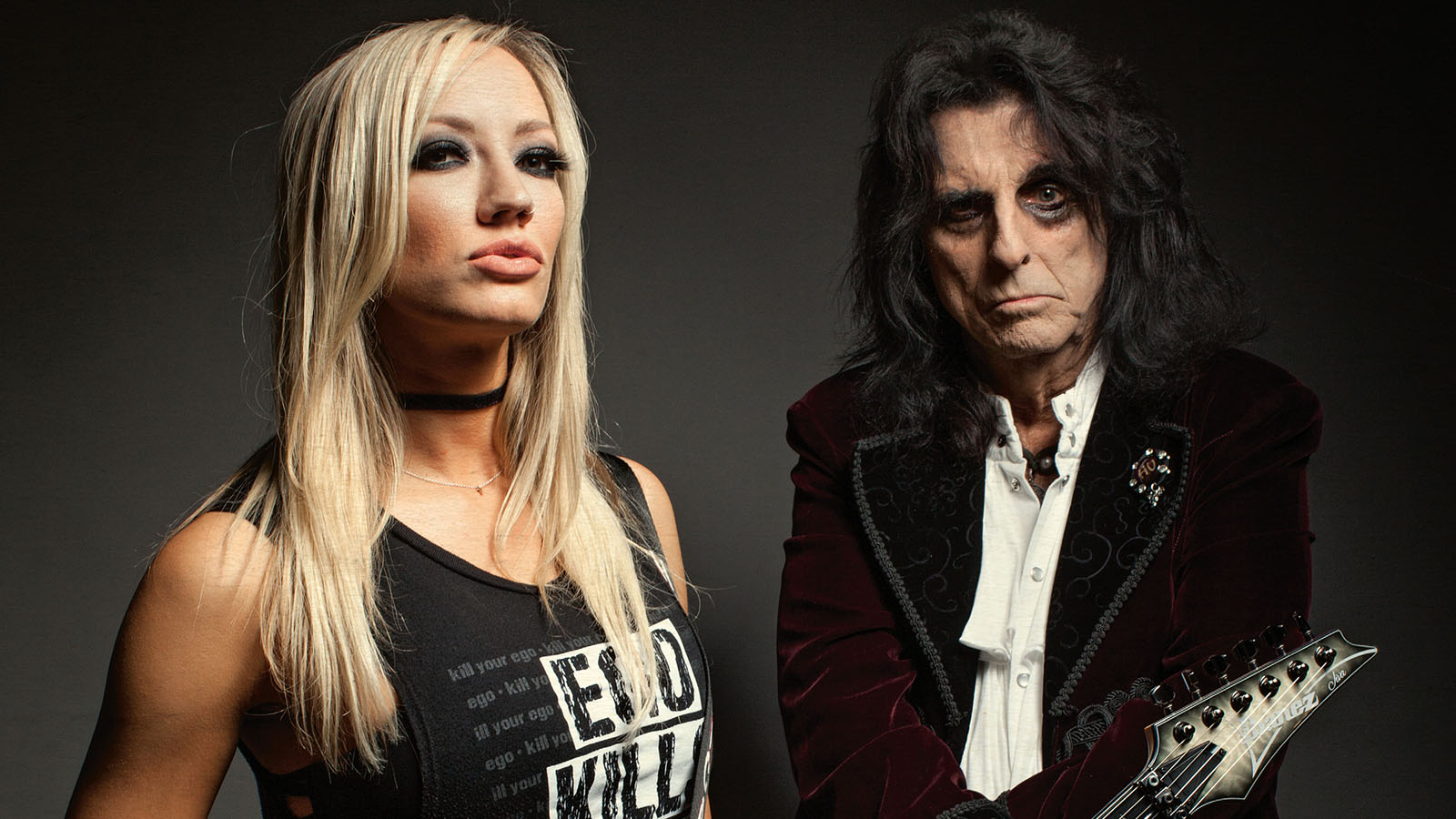
There is a lot of layering and harmony guitar playing on the album. What were your influences in terms of arranging?
I would say first and foremost, the album Colony by In Flames was a huge influence. They’re not doing anything too crazy, but when I was younger, I was really struck by the way that the guitars moved together. Around that same time, I listened a lot to Avenged Sevenfold’s City of Evil, which is a great guitar record. It’s a great record overall, but it’s a really, really awesome guitar record. I was touring with a band at the time, and we were just a bunch of kids in a van listening to Avenged Sevenfold for two months.
Your sound is consistent on the album. Did you use many guitars?
I used my JIVA10 signature Ibanez on 95 percent of the album. I really wanted to put it through its paces. I used every single pickup and tone combination imaginable to try and get as many different sounds as I could, but it’s all coming from the same place. I recorded almost all of it DI through an Apollo Twin by Universal Audio [professional desktop interface]. I’ve always been a proponent of technology in guitars. My first pedal was a Zoom 505 multi-effect pedal, and I’ve been using multi-effect processing on stage ever since.
I think there are two distinct paths to the quest for tone. There’s the analog route: “How can I get the best tubes, the best cable and the best pedals to put in front of the best amp?” Or you can just dial it all in on the digital side. I’m all about the latter. They’ve made leaps and bounds on the digital side, especially in cabinet and speaker simulation. I don’t work with Universal Audio or have an endorsement deal, but I am a lifetime customer because it has done everything I ever needed it to, and it travels with me all over the world. I also use Toontrack EZMix plug-ins. Their metal packs are amazing! When I do a guest guitar solo, I’ll always send a clean DI, in case the producer wants to amp themselves, but I’ll also send a guitar file out with a sound from an EZMix plug-in because they sound that good.
You play many different styles, but I can tell you are a neo-classical girl at heart. Those licks are all over Controlled Chaos.
I grew up in a household that really only listened to classical music, and I purposefully left a lot of that influence off the record, because that style has been done so many times. The last thing I want to do is record a piece that I think is really strong and then have someone say, “Didn’t you know that Joe Stump or Yngwie already did that?” I tried to keep it more straightforward in the direction that I know how to write in, and that I listen to, but that neo-classical inspiration is there.
I felt the album got stronger as it progressed. Even though “Lions Among Wolves” isn’t quite as layered as some of your other songs, it has some of your most interesting soloing on it, especially in the beginning.
After “Pandemonium,” it was the first song I wrote for the album. I wanted to challenge myself, and step out of the chords I usually like to solo over, and let me tell you, that first chord progression was horrible! I don’t like those sharp keys, you know, the E to the F to the G. It was torture trying to find a melody that fit.
Well, it worked for me. Obviously, you’re a great, very ambitious player. What were your practice habits like?
Obsessive, really. It all boils down to hard work. Conor McGregor, the UFC fighter, says there’s no such thing as talent. Talent does not exist, and you can do anything if you put in the time. There is only obsession. It’s just being more stubborn than that voice in your head that says you’re not good, and going in and getting the practice done anyway, you know? You have to do whatever you have to do to get those hours in. And that’s what I made myself do for many years. I was a weird kid. I had a hard time making friends. The only people I was friends with were people I was in bands with, and none of them went to my school. I had one friend, basically, throughout middle school and high school. But when I played guitar, people listened, and that’s the thing that drove me to practice, because I wanted to get better.
Were you always disciplined?
It was in my nature. I grew up doing gymnastics before the guitar distracted me, and I was a couple places shy of the Junior Olympic Team. I was doing ballet and gymnastics from the time I could walk. So, my circle of friends from gymnastics were all focused and driven and dedicated to become the best that we could be. And I’m talking from the time I was 5 until I was 13, when I stopped doing gymnastics and transferred that energy to playing guitar.
How did that dedication affect your social and romantic life?
As a woman in the music industry, you can’t really date a lot of people. I was always extremely careful about who I went out with, and who I talked to. And I avoided dating people in bands I toured with or crew in the tours, or anything like that, because that always reflects on your character and your personality as a musician. In many ways, it was sort of a lonely ascension, because I wanted to do it the way I wanted to do it, and no one else really understood that. That’s the thing that attracts me so much to music and to athletics. To this day, I work out every single day, regardless of where I am in the world, even if it’s just 15 minutes of yoga in my hotel room. No one can do your pushups for you. No one can do your practice hours for you. There are things in life that you can be given, because you have advantages, but guitar technique is not one of them. And that’s something that has always attracted me to this world.

What is it like playing with a legend like Alice Cooper?
Alice is the consummate showman. I’ve always thought of myself as a strong performer, but Alice takes it to another level. He doesn’t break character when he’s on stage — he is Alice Cooper, and he is a frigging badass 100 percent during every show. Our band is such a tight unit, I know when he’s frustrated or tired. But the audience will never know because Alice is such a total pro. I’m guilty of having my moments on stage. I’ve never had a real meltdown, but I’ve had my moments of getting frustrated or kicking someone’s phone out of their hand when they’re texting instead of watching the show, but Alice is a great reminder that you must stay in that character and you must create that experience 100 percent, all the time.
You’ve played in bands with all women, and you’re playing in this band with all dudes. Is there a difference?
Yeah, the guys take longer to get ready! [laughs]
You’ve been very open about being sober. How bad were you that you had to change your lifestyle?
Well, bad enough that I had to stop drinking. I wasn’t to the point where I was waking up and reaching for that bottle of warm vodka sitting next to my bed. Not like that. But I definitely let alcohol and partying dictate way too much of my life for a very long time. A lot of that had to do with insecurities. Like I said, I was a young guitar player on tours with older musicians, and I thought that was the way to be part of the band. Again, I was a weird kid, and I wasn’t great at making friends, but alcohol is the great equalizer. You can walk into any city, any country in the world, and sit down and order a beer and start a conversation with somebody in the bar over a beer. And that was my safety net.
If I made mistakes on stage, I’d say, “Oh, I was kind of drunk that night, it’s okay.” And sort of shift all the blame onto this substance. If I got in an argument with my boyfriend or a friend, I’d say, “Oh, it’s just, I was so drunk that night, it wasn’t actually me. It’s not actually my fault.”
Taking that out of the equation was something that really helped me see who I was as a person and as a guitar player. And I remember my first show that I played sober, I got offstage and I just burst into tears. I know I’m talking about crying so much, but I really did. I burst into tears, I thought, “I can’t do this without my security blanket,” you know? “I can’t do this, nobody liked it, everybody could tell.”
And then I wiped my tears and went out to the bus, and everybody said, “You were so great! You were so confident! I loved the way you moved! I loved the guitar solo!” And I thought, “Wait a second, so nobody knew?” Once I realized that that was all in my head, everything changed and I made a positive shift in my life.
One last thing. Controlled Chaos might never have happened without the direct support of your fans. You raised more than $100,000 through your crowdfunding campaign, which I think is an interesting lesson for other players.
Yes! My Kickstarter campaign was masterminded by Josh Villalta, who is my manager and plays drums on all the tracks of the album. He’s been handling my business for the last few years, and he was the one telling me to crowdfund. To be honest, I was hesitant. I’m not sure why, but I just didn’t want to do it. I thought that a traditional record deal was the way to go, but when we spoke to various labels, there was interest, but nobody was really excited about the project. The typical response was, “Yeah, if you want to do this, we’ll take it. But we want to own everything that you do from here on out.” That really threw me. It made me realize that if I wanted to do something for Wrestlemania, or if I started a band, or guested on an album, it would all have to go through this label, and I’d have to give up so much control of my career. I couldn’t see that happening. What if Alice asked me to play on his next album, and the label started hassling him? I couldn’t have that.
Kickstarter allowed me to move forward, and allowed the fans to get involved. I started seeing how crowdfunding was a cool way to ask, “I want to do this for you guys. Do you want to be a part of it?” The response was a bit overwhelming and humbling. It speaks to the fact that people say rock music is dead, but if you give people something to get behind, if you make a good product, and you know that you’re putting your heart and soul into it, and give people a reason to care, they will care.
A long time ago in a galaxy far, far away Brad was the editor of Guitar World from 1990 to 2015. Since his departure he has authored Eruption: Conversations with Eddie Van Halen, Light & Shade: Conversations with Jimmy Page and Play it Loud: An Epic History of the Style, Sound & Revolution of the Electric Guitar, which was the inspiration for the Play It Loud exhibition at the Metropolitan Museum of Art in New York City in 2019.
